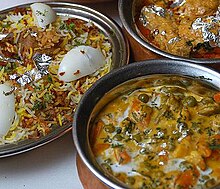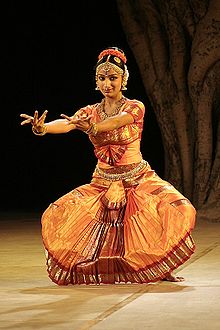Cultural institutions
Andhra Pradesh has many museums, the Salar Jung Museum in Hyderabad, which features a varied collection of sculptures, paintings, and religious artifacts, including the Archaeological Museum at Amaravati near Guntur City that features relics of nearby ancient sites,and the Visakha Museum, in Visakhapatnam, which displays the history of the pre-Independence,and Thotla konda which depicts the age old budhist stupa's and cultural style, Madras Presidency in a rehabilitated Dutch bungalow. Victoria Jubilee Museum in Vijayawada has a good collection of ancient sculptures, paintings, idols, weapons, cutlery and inscriptions. Other ancient sites include dozens of ancient Buddhist stupas in Nagarjunakonda which is now an island in Nagarjuna Sagar, an artificial lake that formed after the construction of Nagarjuna Sagar Dam. The Island has a large museum that houses many Buddhist relics.
Cuisine
The cuisine of Andhra Pradesh is one of the spiciest of all Indian cuisines. There are many variations to the cuisine (all involving rice) depending on geographical regions, caste, and traditions. Pickles and chutneys, called thoku also called as pachadi in Telugu, are particularly popular in Andhra Pradesh and many varieties of pickles and chutneys are unique to the State. Chutneys are made from practically every vegetable including tomatoes, brinjals (eggplant), and roselle (Gongura).Avaakaya (mango) is probably the best known of the Andhra Pradesh pickles.
Rice is the staple food and is used in a wide variety of ways. Typically, rice is either boiled and eaten with curry, or made into a batter for use in a crepe-like dish calledattu (pesarattu is made of a mixture of this batter and mung beans) or dosas, a crepe filled with black beans or lentils.
Meat, vegetables and greens are prepared with different spices (masala) into a variety of strongly flavored dishes such as Hyderabadi Biryani, fish curry, brinjal curry, andGongura pachadi the most popular dish of andhra pradesh.An Andhra dish is recognized with the dish being listed in the menu.The coastal region is even more well versed with the varieties in sea food "chapala purulusulu"specially known for "Bommidala pulusu","Koramenu kura". Especially Hyderabadi cuisine is influenced by the Muslims who arrived in Telangana in the 14th century. Much of the cuisine revolves around meat. It is rich and aromatic, with a liberal use of exotic spices and ghee (clarified butter). Lamb, chicken, and fish are the most widely used meats in the non-vegetarian dishes. Biriyani is perhaps the most distinctive and popular dish of Hyderabadi cuisine.
Dance
Classical dance in Andhra can be performed by both men and women; women tend to learn it more often. Kuchipudi is the state's best-known classical dance form. The various dance forms that existed through the state's history are Bonalu, Dappu , Chenchu Bhagotham, Kuchipudi, Bhamakalapam, Burrakatha, Veeranatyam, Butta bommalu, Tappeta Gullu, Lambadi, Dhimsa,Kolattam, and Chindu. Jaanapadam theenmar is a popular folk dance.
Jayapa Senani was the first person to write about the dances prevalent in Andhra Pradesh. Both Desi and Margi forms of dances are included in his Sanskrit treatise Nrutya Ratnavali.
Festivals
Just like in other parts of the country, many festivals are celebrated in Andhra Pradesh. However, certain festivals epitomize the culture of the state better and reflect its unique identity. These include Ugadi-which begins the Telugu New Year,Sankranthi-which is a harvest festival and Vijayadashami/Dasara. Bonalu and Batukamma are celebrated with gusto especially in the Telangana region. Brief details of these and other festivals are provided below.
- Eid ul Fitr celebrated according to Muslim Lunar Hijri Calendar
- Eid ul Adha celebrated according to Muslim Lunar Hijri Calendar
- Sankranthi in January
- Maha Shivaratri in February/March
- Holi in March
- Ugadi or the Telugu New Year in March/April
- Muharram celebrated according to Muslim Lunar Hijri Calendar
- Milad-un-Nabi celebrated according to Muslim Lunar Hijri Calendar
- Sri Rama Navami celebrated in March/April, nine days after Ugadi
- Bonalu Celebrated in Telengana Region only in the month of July/August
- Nagula Chaviti in August
- Varalakshmi Vratham in August
- Rakhi poornima in August
- Vinayaka Chavithi in August/September
- Dasara in September/October
- Deepavali in October/November, 20 days after Dasara
- Batukamma celebrated for nine days during Durgastami (called as Navratri–Dasara in Telangana region)
Games
Outdoor games include Cricket, Football, Kabaddi, Kho Kho, Gilli-danda, Gilli Kaama, Gooti Billa, Gujjana Goollu, Gotilu, lingosh, Kothi Kommachi, Nalugu Stambhalata, Nalugu Rallu Aata, Tokkudu Billa, Goleelu and Nela-Banda. The major outdoor game played is cricket. Indoor board games include Puli Joodam, Carroms, Ashta Chamma, Dahdi, Vamagunatalu, Vaikuntapali, Gavalu Aataa and Chintha Ginjallu Aataa. Achenagandlu, Ramudu Sita, star, ashtachamma are indoor games played by children and elders.
Literature
Nannayya, Tikkana, and Yerrapragada form the trinity who translated the great Sanskrit epic Mahabharata into Telugu. Bommera Pothana is the poet who composed the classic SriMad Maha Bhagavatamu, a Telugu translation of Sri Bhagavatham, authored by Veda Vyasa in Sanskrit. Nannayya (c. 11th century AD), the earliest know Telugu author, was patronized by the king Rajaraja Narendra who ruled from Rajamahendravaram (now Rajahmundry). The Vijayanagara emperor Krishnadevaraya wrote Amuktamalyada. The Telugu poet Vemana, a native of Kadapa, is notable for his philosophical poems. Telugu literature after Kandukuri Veeresalingam (1848–1919) is termed modern literature. Known as Gadya Tikkana, Satyavathi Charitam was the author Telugu-language social novel, Satyavathi Charitam. Jnanpith Award winners include Sri Viswanatha Satya Narayana and Dr. C. Narayana Reddy. The Andhra Pradesh native and revolutionary poet Sri Sri brought new forms of expressionism into Telugu literature.
Other modern writers include Gunturu Seshendra Sarma, the only person nominated from India for a Nobel prize in literature since Rabindranath Tagore. The West Bengal Government conferred on him the titleRashtrendu ("Moon of the Nation"). Telugu University awarded him an honorary Doctorate in Literature in 1994. He received the Kalidas Samman award from the Madhya Pradhesh government, and he won the Central Sahitya Akademi fellowship in 1999.
Seshendra's first work in print appeared in 1952.[1] It is the translation of Matthew Arnold's Sohrab and Rustum, which is based upon the Persian Epic Shahnama. Initially he focused on poetry and occasionally worked on literary criticism. Seshendra's first collection of prose-poems Sesha Jyotsna. He composed it strictly conforming to Telugu prosody which was published in 1972 in Telugu and English. Its translations into Hindi and Urdu appeared separately. His magnum opus was Naa Desham, Naa Prajalu (My Country, My People, Meri Dharti, Mere Log). It led to his nomination for the Nobel Prize in Literature in 2004.
Shri Puttaparthi Narayanacharyulu is one of the scholarly poets of Telugu literature. He wrote the books Sivatandavam and Panduranga Mahatyam.
Other notable writers from Andhra Pradesh include Srirangam Sreenivasarao, Gurram Jashuva, Chinnaya Suri, Viswanatha Satyanarayana.
Movies
Andhra Pradesh has around 3,300 cinema halls. The state produces about 200 movies a year. It has around 40% (330 out of 930) of the Dolby Digitaltheatres in India. It houses an IMAX theatre which was the biggest 3D IMAX screen in the world when it was built in 2007: the Prasads IMAX. Tollywood produces the largest number of movies in India per year. It is also home to Ramoji Film City which is the world’s largest integrated film studio complex at over 2,000 acres (8.1 km2) of land.
Music
Many composers of Carnatic music like Annamacharya, Tyagaraja, Kshetrayya, Syama Sastri and Bhadrachala Ramadasu were of Telugu descent. Modern Carnatic music composers like Ghantasala and Sri M. Balamuralikrishna are also of Telugu descent.
The local film industry hosts many music composers and playback singers such as S. P. Balasubrahmanyam.
Folk songs are popular in the many rural areas of the state. Forms such as the Burra katha and Poli are still performed today.


No comments:
Post a Comment